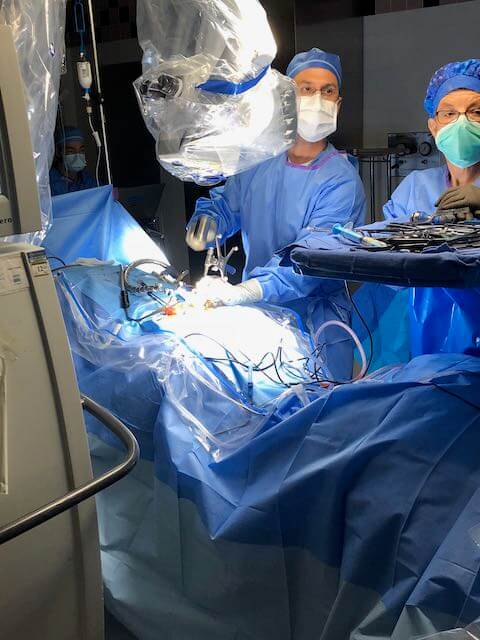
Advances in technology and medicine have led to the development of procedures that are faster and safer, while requiring less time to recover, than “open” procedures that involve a greater extent of muscle dissection and tissue disruption surrounding the surgical area.
“Minimally invasive” means the procedure may result in smaller incisions, less surgical trauma, and less bleeding than traditional surgery. The “robot” is not actually an android performing the surgery, but rather a console that allows the surgeon to precisely guide instruments in an area that’s much smaller than open surgery, or can take accurate images of the surgical site that are shown on a large screen for the surgeon to view.
Not every spinal condition will require surgery, and whether your spinal procedure will be minimally invasive or open depends on the condition and the patient, which is why it’s important to receive a full consultation, including a history, physical, and neurological exam, to plan the best course of treatment for your unique situation.
Even the most modern techniques are only as successful as the surgeon using them, so it’s important to choose a surgeon who is experienced, skilled, and comfortable performing these procedures. In the Athens area, Dr. Woodall (and his partners at Georgia Neurological Surgery) stands out with the ability to offer both minimally invasive and robotic spine surgery for patients seeking treatment for a wide range of spine disorders and conditions.
Conditions Treated with Minimally Invasive and Robotic Spine Surgery
A wide range of conditions related to spinal deformities, traumatic fractures, and tumors can be treated with minimally invasive and robotic spine surgery. These include:
- Degenerative disc disease — Also known as osteoarthritis or spondylosis, degenerative disc disease occurs when one or more of the discs between the vertebrae loses cushioning, fragments, or becomes herniated. Depending on the severity of the condition, surgery may be unnecessary, but it can lead to other spine conditions including abnormal spine curvature or spinal stenosis (see below).
- Spine curvature — A spine that curves abnormally is referred to as either kyphosis (curved in a hunchback or rounded shape) or scoliosis (curved sideways in an “S” or “C” shape). These conditions are often noticed during childhood screenings, but they can also present or worsen during adulthood. These conditions in adults can be caused by degenerative spinal arthritis (spondylosis) due to age-related wear and tear. Abnormal spine curvature in children can often be corrected with a brace and physical therapy, but surgery may be necessary, especially if nerve compression is involved.
- Spondylolisthesis – When a slipped vertebra presses on a nerve, it can cause a range of pain symptoms in the lower back and legs. Spondylolisthesis can be congenital (meaning a person is born with a defective vertebra), caused by an injury, result from wear and tear due to aging, or caused by another condition, such as osteoporosis.
- Spinal stenosis – The spine serves to protect the spinal cord, but if it gets too narrow, pressure on the nerves can cause weakness, tingling, pain, and problems with balance or walking; symptoms vary depending on which nerves are affected. Several factors can cause spinal stenosis, including osteoarthritis, herniated disks, tumors inside the spinal cord, and injuries affecting the area.
- Radiculopathy – A term for conditions caused by compression or irritation of spinal nerves, radiculopathy is often referred to as “pinched nerves.” Compressed nerve roots can cause numbness, weakness, or pain. Radiculopathy, which usually affects people between the ages of 30 and 50, is classified by the location of the affected nerve:
- Cervical radiculopathy, affecting a nerve root of the neck, can cause your shoulder, arm, hand, or fingers to feel numb, weak, burning, or tingling.
- Thoracic radiculopathy affects nerves in the upper back area of the spine, causing chest and torso pain.
- Lumbar radiculopathy involves pressure on nerve roots in the lower back. Common symptoms include weakness or pain in the legs or hips, as well as sciatica. Paralysis is also possible.
- Spinal tumors – Occasionally, tumors may occur in the spine, causing pain, paralysis, and other spinal conditions. Robotic surgery can be a useful tool in the treatment of spine tumors.
The most common procedure performed using the robot is the minimally invasive transforaminal lumbar interbody fusion (TLIF). This procedure is used to treat patients who usually have low back and leg pain related to spondylolisthesis. In a TLIF, the nerves are decompressed and the unstable vertebral segments are stabilized using a spacer that is placed in the disc space (between the two vertebral bodies) and bolstered by a screw-rod construct. Robotic surgery and intra-operative navigation can improve the safety and accuracy of hardware placement.
Contact M. Neil Woodall, MD, Today
If you require a surgical evaluation for disorders involving the cervical, thoracic, or lumbar spine, Dr. Woodall has the skill, care, and experience to ensure you receive the treatment you need—without leaving the Athens area. Contact our office today.